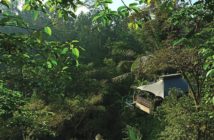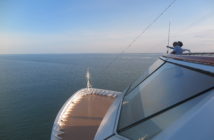Cambodia has cast aside its grim past to become a hip and happening destination. Peter Lynch reports.
In a region that’s renowned for doing deals, Cambodians appear charmingly inept. Try making an offer of 50 per cent or less on a ticket price in Hong Kong, China or Vietnam and you will be met with an icy glare and a bout of pouting histrionics. But in Cambodia, despite the poverty, bargaining is an altogether good-natured process. Every time we approach a tuk tuk driver, we are told the price is US$5. We already know it is US$1 per person (a price that seems to pertain however far we travel). After a vain attempt at a US$3 compromise, every driver settles cheerily for the going rate. It’s the same in the markets and even at the famed Angkor Wat temple, where guidebook prices start at a bullish US$10 but end the day at US$1. Oil on canvas depictions of the famous temple sunrise similarly plunge from US$30 to just US$5.
We are visiting Siem Reap and Phnom Penh during the peak season between November and March. While high season elsewhere seems to bring on a fit of the grumps, it’s different story here – the people’s sunny disposition is a joy. Despite the Khmer’s ancient civilisation and the country’s sad recent history, Cambodia today is a hip and happening place. Everywhere, there is a newfound pride in local culture. Nowhere is this more apparent than restaurants where young chefs have reinstated pure Khmer cuisine and created modern, fresh establishments in which to sample it. And the world is responding – Siem Reap’s tourist visitor numbers have soared in the last decade from 200,000 to 4.5 million a year.
While staying in Siem Reap, we take a boat trip to Tonle Sap, the largest inland lake in Cambodia and home to an eclectic mix of Vietnamese boat people, fishing families, floating churches and fish farms. The boat journey shows the massive changes in Cambodia. The once thronging riverbanks are now stripped bare – the houseboats have moved on as the government begins to develop a huge fish market, our Insider Journeys guide tells us. In Siem Reap we are staying at the Raffles Grand Hotel D’Angkor – a stately colonial building overlooking the Royal Gardens, where a procession of brides have their wedding photos taken. It’s an amazing slice of life that would have anyone from the fashion industry reeling in horror; it seems there is no dress code for Cambodian weddings. At the heart of the hotel is a 35-metre pool, the perfect haven from temperatures that soar past 30 degrees.
Of course, Siem Reap has a global rock star on its list of must-sees – Angkor Wat. The best time to see it is at sunrise and we are not alone as we jump into a tuk tuk for the 10-minute pre-dawn ride there. The trek is a little like a trip up Sydney’s Parramatta Road. There are coaches and cars. Cycles and motorbikes. And literally hundreds of tuk tuks. But as with everything in Cambodia, it is all conducted with civilised good humour. There is a brief stop on the way to have a one-day US$20 temple pass created complete with photo – be prepared for every guard to say the picture looks nothing like you; it is the tourism ministry’s joke of the month. Suddenly, we are excitedly standing in front of a lake waiting for the sun to rise in front of the legendary temple of Angkor Wat. There are about 300 people standing alongside us, armed with everything from mobile phones and iPads to the kind of camera kit that commands respect. The selfie stick is particularly prevalent. There is an air of expectancy. Slowly, a familiar shape emerges from the shadows, as it has done for centuries. The cameras, phones and selfie sticks go into hyper-drive. Sun up and pictures taken, we roam the monument and marvel at how the Khmer culture created one of the world’s greatest empires that spanned 600 years between the ninth and 15th centuries.
To my shame, I had no idea that Angkor, the city where the temples were built and the former capital of the Khmer Empire, was once the largest city in the world with a population of 1 million. While there, we also visit the Bayon temple, renowned for its 216 immense stone faces, and Ta Prohm temple, where Angelina Jolie filmed Tomb Raider and where the enormous power of the jungle to reclaim its own is on show as tree roots gobble up the temple walls. The stones for the temples came from 70 kilometres away, carried by elephants, and the huge task of carving the statues and walls went on for decades. But by the 16th century, Angkor’s temples had been abandoned. Their ruins were rediscovered in the 1860s, but reconstruction has been slow and is still incomplete.
While the temples are its main drawcard, Siem Reap has other attributes – food being chief among them. Khmer cuisine is a softer version of the fiery curries of its neighbours. Spices play an important part, and chilli is not so prevalent. Raffles hotel continues the tradition of having concierges that really know their stuff. We try every one of their restaurant recommendations, and they all prove terrific. Chanrey Tree, a stylish restaurant at the cutting edge of new Khmer cuisine, and Viroth’s are especially good. We also try a cooking class at Raffles, when we are shown how to prepare a red curry and one of the most delicious desserts imaginable – pumpkin custard, a hollowed out pumpkin filled with coconut egg custard.
From Siem Reap, we take a 40-minute Cambodia Angkor Air flight to Phnom Penh. We may as well have arrived in another country. Like every major Asian city, Phnom Penh never sleeps. Every kind of enterprise is being conducted on every street corner and tuk tuks race enormous loads of human and commercial cargo along the streets. We are warned to hang on to our bags, as motorcycle thieves snatch them as they go by. Many tuk tuk drivers now have metal screens around their passengers. Insider Journeys had booked us into our second Raffles – this time Le Royal. It’s a beautiful cream-painted French colonial building surrounding two central pools; an oasis in the middle of a bustling metropolis.
The mighty Mekong is at the heart of the city – and we have an appointment on board one of the newest and must luxurious ships to ply its waters. From the banks of the river, we see cruise ships everywhere. But they are eclipsed by Aqua Expeditions’ eclectic Aqua Mekong – described as the first true luxury small ship to sail this waterway. The Aqua Mekong certainly looks different, a bit like a rustic floating shed, with timber and black panels, and floor-to-ceiling windows. Aqua Expeditions has two similar ships in South America, but this is its first Asian venture.
The line’s signature is luxury. There is a pool, spa and cinema. The ship has a crew of 40 and room for 40 guests. Cabins are beautifully designed with wood trimmings. The food has been created by Australian chef David Thompson whose Bangkok restaurant, Nahm, has been named one of the world’s top 50, thanks to his astonishing ability to cook Thai food better than the Thais. Thompson, who is on board when we visit, has adapted his recipes to include the river’s plentiful supply of prawns and catfish. As we leave, the guests are piling aboard – including two Australians who tell us they simply Googled “Mekong and luxury” to find the ship.
No visit to Phnom Penh is complete without seeing the museums that are a testament to the genocide carried out by the Pol Pot regime during the 1970s. You will need to brace yourself for a harrowing period of introspection. S21 was an ordinary high school on the outskirts of the city. Its nondescript nature is poignant. Some 14,000 men, women and children where taken into its courtyard, shackled to iron beds and tortured by mainly teenage guards. Only seven survived. Extraordinarily, in a bizarre and horrifying act of bureaucracy gone mad, each one was photographed. Their pictures adorn the walls, their faces staring out in horror and resignation. It is an uncomfortable but essential ingredient of a visit to Cambodia.
But beyond these walls, an altogether different country now bids the world welcome. The new Cambodia has experienced strong economic growth, led largely by tourism. It has embraced ethical tourism, too. There are a number of restaurants and even a circus, which help street children train and find work. Insider Journeys is a partner of the Childsafe network that, among other things, discourages visits to orphanages, making the point that children “are not tourist attractions”.
We visit the Royal Palace – great buildings, but too many are closed to tourists – and the Foreign Correspondents Club, which has terrific views of the Mekong. The Russian market sells everything from imitation Louis Vuitton to food. Fake watches are scooped out of displays by the handful, so don’t expect a lifetime warranty. If you feel like a snack, there are fried tarantulas and crispy locusts to sample. We give them a miss, preferring Friends restaurant, which employs street kids and teaches catering. An organised tour/itinerary is a good way to see Cambodia. We were certainly glad to be in the hands of a reputable company with knowledgeable local guides.



